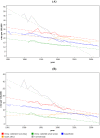The changing face of esophageal cancer
- PMID: 24281163
- PMCID: PMC3837312
- DOI: 10.3390/cancers2031379
The changing face of esophageal cancer
Abstract
The two main histological esophageal cancer types, adenocarcinoma and squamous cell carcinoma, differ in incidence, geographic distribution, ethnic pattern and etiology. This article focuses on epidemiology with particular reference to geographic and temporal variations in incidence, along with a review of the evidence supporting environmental and genetic factors involved in esophageal carcinogenesis. Squamous cell carcinoma of the esophagus remains predominantly a disease of the developing world. In contrast, esophageal adenocarcinoma is mainly a disease of western developed societies, associated with obesity and gastro-esophageal reflux disease. There has been a dramatic increase in the incidence of adenocarcinoma in developed countries in parallel with migration of both esophageal and gastric adenocarcinomas towards the gastro-esophageal junction.
Figures



References
-
- Ferlay J., Bray F., Pisani P., Parkin D.M. GLOBOCAN 2002: Cancer Incidence, Mortality and Prevalence Worldwide. IARC Press; Lyon, France: 2004.
-
- Kmet J., Mahboubi E. Esophageal cancer in the Caspian littoral of Iran: initial studies. Science. 1972;175:846–853. - PubMed
-
- Day N.E. Some aspects of the epidemiology of esophageal cancer. Cancer Res. 1975;35:3304–3307. - PubMed
LinkOut - more resources
Full Text Sources

